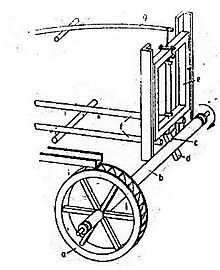Knock saw
A knocking saw or plotting saw , also known as a flail saw in Switzerland , is a simple type of gang saw powered by water power . This sawing technique was first mentioned in a document in the Black Forest in 1314 and was used for several centuries to cut logs .
function
The term flail saw is derived from a very simple functional principle of the saw powered by water power. The saw frame is lifted by a flail, a cam on the drive shaft of the water wheel . In the highest position, the flail turns away from the gate so that it falls down due to gravity and makes the saw cut. The falling gate is cushioned by wooden poles clamped on one side, the rods , which gives the typical beating, knocking noise of the system. A part of the weight of the gate is taken up by a wooden rod attached above it, also clamped on one side, the long tree , which also dampens the fall of the gate. The cutting process is repeated several times with each turn of the mill wheel, depending on the number of flails, up to three can be attached.
The trolley with the material to be sawn is usually moved forward by a pawl that engages in a rack on the side of the trolley and is driven by the gate via a lever mechanism.
The tree trunks are cut lengthways by the single-leaf saw frame. Such a saw could process about 1.5 to 3.5 solid cubic meters of log into sawn timber per day . It was not until the invention of the connecting rod saw and later the full frame saw that the sawing performance of frame saws increased considerably.
construction
The flail saw consists of wood and stone with the exception of a few iron parts; As iron used to be precious and expensive, it was only used where it was absolutely necessary. The wave tree is made of oak .
Received plants


In the southern Black Forest there is the Fröhnder knocking saw at Fröhnd , the Kingenhofsäge in the Löffeltal at Hinterzarten and a saw from 1673 in the Black Forest open-air museum Vogtsbauernhof. A knocking saw from 1731 is the sawmill in the Ettersbach , which was converted into a high-speed saw in 1879 .
In the northern Black Forest there is the Plotzsägemühle Loffenau in the Gaistal between Bad Herrenalb and Loffenau . It was first mentioned in the 13th century and renewed in 1699. In Switzerland there is a single functioning hammersaw in Kleinteil , a district of the municipality of Giswil around 30 kilometers south of Lucerne . It originally comes from the Black Forest and was built in 1860, restored by volunteers between 2000 and 2004 and put back into operation. With a gradient of around 50 centimeters, the water drives the mill wheel with a diameter of around three meters with 23 chambers of 40 liters each. The 60 centimeter thick wave tree is made of oak .
Web links
- Fröhnd - historical knocking saw 1808 (southern Germany)
- Kingenhof saw 1828 (Hinterzarten)
- Flail saw Giswil (Switzerland)
Individual evidence
- ↑ Heimatpfad Hochschwarzwald: The development of sawing machines in the Black Forest. In: Wikimedia Commons. Retrieved October 20, 2013 .
- ↑ vom Ettersbachhof is newly restored Website Ettersbachhof
- ↑ Kleinteiler flail saw ( Memento of the original from May 14, 2013 in the Internet Archive ) Info: The archive link was inserted automatically and has not yet been checked. Please check the original and archive link according to the instructions and then remove this notice. (PDF; 306 kB)
